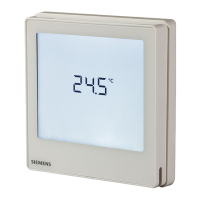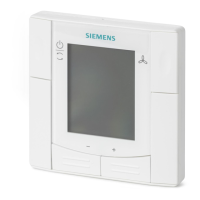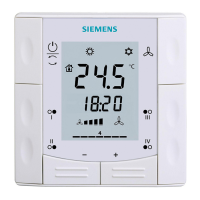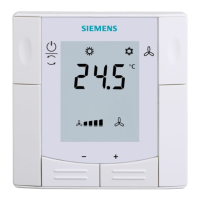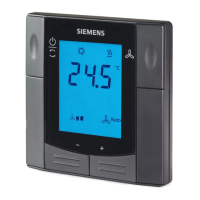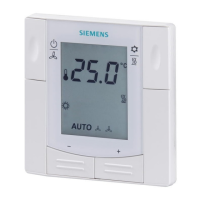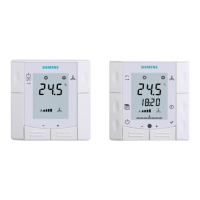61 / 94
Siemens RDF800KN.., RDF800KN/VB, RDD810KN/NF Basic documentation CE1P3174en
Smart Infrastructure 2020-02-21
3.12.3 Description of communication objects
Obj Object name Function Type/length Flags
1 System time Time and
date
19.001
8 Byte
CWU
System time for display on the room thermostat. See P07 (3 or 4)
3 Time of day Time and
date
10.001
3 Byte
CWU
Another object for receiving the time of day for display on the
thermostat. See P07 (3 or 4)
4 Fault information Alarm
Info
219.001
6 Byte
CT
Common alarm output. If an alarm occurs, the alarm number is
transmitted
5 Fault state Faulty/
Normal
1.005
1 bit
CT
Common alarm output. If an alarm occurs, the alarm flag is set
6 Fault
transmission
Enable/
Disable
1.003
1 bit
CWU
A supervisory alarm system can disable the broadcasting of alarms
by the devices. This has no impact on the local display of alarms.
After a timeout of 48 hours, the sending of faults will automatically
be enabled again.
7 Room operating
mode:
Preselection
Auto
Comfort
PreComf.
Economy
Protection
20.102
1 Byte
CWTU
Controls the room operating mode selection of the thermostat via
the bus.
The command can also be submitted as four 1-bit communication
objects (8...11). The last selected option is implemented – either
from the local operating mode icon or using the bus.
Note: The thermostat will switch form Precomfort to Economy or
Comfort mode (selectable via P88).
8
9
10
11
Operating mode:
Preselection
Auto
Comf
Eco
Prot
Trigger 1.017
1 bit
CW
Switch the room operating mode to Auto, Comfort, Economy or
Protection.
The last selected option is implemented – either from the local
operating mode icon or using the bus.
12 Room operating
mode: Time
switch
Comfort
Economy
PreComf.
Protection
20.102
1 Byte
CWU
This information is provided by a central time switch or a
supervisor and defines the current HVAC operating mode.
The command can also be submitted using three 1-bit
communication objects (13...15).
Protection has the highest priority and cannot be overridden.
Note: The thermostat will transform Precomfort into either
Economy or Comfort (P88).
13
14
15
Time switch
Comfort
Economy
Protection
Trigger 1.017
1 bit
CW
Switch the HVAC mode to either Comfort, Economy or Protection
mode.
Obj Object name Function Type/length Flags
16 Room operating
mode: State
Comfort
Economy
Protection
20.102
1 Byte
CRT
Effective room operating mode used by the thermostat
(considering time switch, user selection, window contact, etc.) This
state information is available using one 8-bit enumeration or three
1-bit communication objects (17...19). Note: The thermostat does
not support Precomfort.
17
18
19
Room operating
mode:
State Comfort
State Economy
State Protection
ON
OFF
1.002
1 bit
CT
Corresponding communication object sends "True"
20 Window state Open
Closed
1.019
1 bit
CWU
The RDF is set to Protection if value "1" (open) is received. It
switches back to the previous mode when the value is "0" (closed).
"Window state" is sent (e.g by a KNX switch). It has the same
effect as the local window contact X1, X2 (P38, P40).
Only one input source must be used, either local input X1/X2 or
KNX bus.
21 Room
temperature
Temp.
value
9.001
2 Bytes
CRT
The value of the room temperature measured using built-in or
external sensor is available with this communication object.
22 Room tempera-
ture: Comfort
basic setpoint
Temp.
value
9.001
2 Bytes
CWU
If the Temporary setpoint function is enabled using P69, then after
an operating mode change, the setpoint adjustments made by the
user, and communication object 23 are dismissed and the
thermostat is reset to the Comfort basic setpoint.
Note: Setpoints that have been changed using the local HMI may
be overwritten during a system startup from a central control unit,
e.g.RMB795B.
The Comfort basic setpoint is stored in EEPROM (see section
3.3.2).
à
The service life of the EEPROM depends on the number
of write cycles. Never write this communication object cyclically!
23 Room
temperature:
Comfort setpoint
Temp.
value
9.001
2 Bytes
CWTU
Communication object is used to shift the setpoint used by the
thermostat (see section 3.3.2). Same priority as local setpoint shift
on the thermostat. The last selected option is implemented.
Note: The Comfort basic setpoint (object 22) is not changed.
24 Current setpoint Temp.
value
9.001
2 Bytes
CRT
This is the current setpoint, including shift, compensation, etc.,
used by the thermostat for room temperature control
25 Heating output
primary
0…100 % 5.001
8 bit
CRT
Indicates the position of the heating actuator of the first stage.
E.g. 2-pipe with electric heater application: Output of heating coil.
26 Heating output
secondary
0…100% 5.001
8 bit
CRT
Indicates the position of the heating actuator of the second stage.
E.g. 2-pipe with electric heater application: Output of electric
heater.
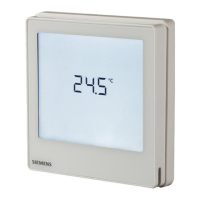
